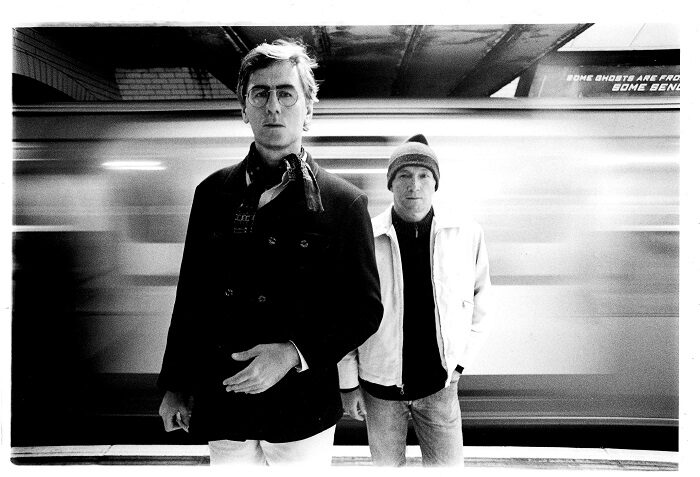An inevitable hole lies at the center of Kriv Stenders brilliant new documentary The Go-Betweens: Right Here. In its opening image, a besuited, silver haired Robert Forster walks a country lane, guitar case in hand, and we are painfully conscious of the shorter figure who should be walking beside him.
From 1977 until 1989, and again from 2000 until 2006, Robert Forster and Grant McLennan were, as a voice in this film states, an “indie Lennon and McCartney.” Even that pigeon-holes their timeless, heartfelt songwriting too much. In The Go-Betweens, Forster was the original writer, his songs angular, sharp, loaded with unorthodox time signatures. McLennan’s songs, warmer and smoother but riven with undercurrents. There is speculation that single Hammer The Hammer refers to drugs, while the lines “Watch the butcher shine his knife/And this town is full of battered wives,” cast a dark shadow within 1988’s infectious should-have-been-a-hit, Streets of Your Town.

Stender’s film tracks Foster and McLennan’s progress from their meeting in a literature class at the University of Queensland through to McLennan’s untimely death thirty years later. Debuting with a single that proclaims love for a librarian who helps him track down editions of Genet, Brecht, and Chandler, the bookish duo were immediately out of step with Australia’s “beefcake” music scene. Self-belief and naivety brought Forster and McLennan to London where they were positive that stardom awaited. It didn’t, and after recording a single for Glasgow’s legendary Postcard Records, they were on their way back home.
Despite constant bad luck with record companies, a succession of classic records followed, while a full band gradually coalesced around the two songwriters. Forster’s girlfriend Lindy Morrison joined on drums in 1980, while McLennan’s partner to be, multi-instrumentalist Amanda Brown, arrived in 1986. The tumult of romantic relationships and strong personalities proved combustible. Sometimes The Go-Betweens were “more like a social experiment than a band” is the assessment of Robert Vickers, the group’s longest serving bassist.

An impressive array of contributors is assembled. Every surviving member of the band’s initial run appears, their appearances privileged by being shot in brilliant color. In contrast, an engaging collection of managers, friends, family, and contemporaries such as Ed Kuepper (The Saints/Laughing Clowns), Mick Harvey (The Birthday Party/Bad Seeds), Lloyd Cole, and David McClymont (Orange Juice) appear in black and white to provide their own reminisces. Whilst the figure of Grant is much missed, particularly in the widescreen shots of Robert Forster surrounded by green fields, an impressive array of archival material: radio and tv interviews, concert and more informal footage, and even a student film, ensure that his voice is never noticeably absent.
Kriv Stenders is a veteran director who actually cut his teeth on that student film of Grant’s, subsequently directing the video for The Streets of Your Town, before switching to dramatic features (Wikipedia informs me that his latest work is a mini-series based on the source novel for Ted Kotcheff’s 1971 outback chiller Wake In Fright). Right Here is his first documentary, and with its lush cinematography and its compelling narrative arc, it grips as a work of cinema in a manner that eludes so much of the glut of music documentaries that we’ve seen in recent years.
Some of the most affecting minutes of the film come with Robert and Grant’s (short lived) decision to scale the band back to a duo following the disappointing response to16 Lovers Lane (1988), their classic sixth album. The hurt caused to Lindy and Amanda by their plan, and the clumsy manner in which it was conveyed, persists to this day. Stenders cuts between the parties as they each give their side of the events, but he refuses to let the men off lightly. The camera maintains its gaze on Robert Forster’s haunted features as Amanda describes packing her bags and leaving Grant, a loss you suspect he never fully recovered from.
Forster and McLennan pursued unspectacular solo careers for much of the following decade, details of which go unmentioned. The exception is the Jack Frost project which saw Grant teamed with The Church’s Steve Kilby. His is the grimmest contribution to the film, vividly elaborating on a side of Grant – his drug use – that although no secret has never, at least in my experience, been described with such candor.
And then we are in Portland. Accepting that the push they gave to each other meant that Robert and Grant were at their best when working together, they reconvened with engineer Larry Crane at Jackpot Studios in 2000 to record a new Go-Betweens album, this time backed by members of Sleater-Kinney and Quasi. Belying common wisdom on the success of band reformations, none of the magic was lost. Friends Of Rachel Worth is a warm, beautiful album. Two more were to follow.
The Go-Betweens came to a sudden end on May 6, 2006. Resting prior to a party at his Brisbane home, Grant McLennan suffered a heart attack, tragically dying at the age of 48. In addition to the loss of his close friend, for Robert Forster further disappointment remains. Grant and he created some of the greatest music of their era, yet the vindication of a hit record eluded them. Devotees of their band will have no regrets in regard to this documentary. With The Go-Betweens: Right Here, Kriv Stenders has crafted a fine tribute to a beloved band and to a long friendship, the qualities of both all too rare.
The Go-Betweens: Right Here is currently available to stream on Vimeo:
Also available now is the book Grant & I: Inside and Outside The Go-Betweens by Robert Forster (Omnibus Press).






